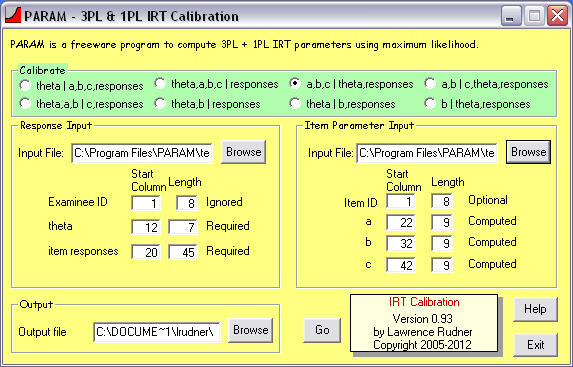PARAM
Calibration Software for the 1 & 3 Parameter Logistic IRT Models
Release 0.93 August 2012
![]()
This page in French thanks to Vicky Rotarova
PARAM is a public domain, freeware tool for calibrating items and individuals using the 1 & 3 parameter logistic item response theory models. Parameterization uses Newton-Raphson maximum likelihood estimation as outlined in Lord (1980). It runs on Windows XP, Windows 7 and probably other Windows® operating systems. Earlier versions were called PARAM-3PL and PARAM-1PL.
The software is written in PowerBasic and I would be happy to share the source code with other psychometricians that program in PowerBasic. If you are not familiar with Powerbasic, please do check out their web site http://www.powerbasic.com. Perhaps the best feature is the extensive support through their forums. Questions at all levels are quickly answered. Hundreds of megabytes of free source code are provided. If you can program in .ASP or QuickBasic, you will find Powerbasic quite easy to learn.
** DOWNLOAD **
ZIP archive – extract these files into a new directory

UPDATE HISTORY
Release 0.93
· Rasch (1PL) and 3PL combined, massive sample size support added.
Release 0.91
· Now computes [theta ,a, b | c, responses ]
Release 0.90
· Corrects output when record length is less than the number of questions
Release 0.89
· Maximum number of items increased from 99 to 9,999
· Option to standardize theta when simultaneously calibrating theta and a,b,c given item responses
· Correction of treatment of missing data with simultaneous calibration
· Correction of computation of mean square error – affected the number of iterations with simultaneous calibration
Release 0.83
· Original public release
CALIBRATION OPTIONS
You can calibrate
· Examinee ability (theta) given the item responses and item parameters
· Item parameters given theta and item responses
· The a and b item parameters given the c parameter, theta and item responses (I am trying this for calibration in a CAT environment)
· Theta and item parameters given the item responses. (This requires many iterations, lots of items and lots of examinees).
· Standardize theta
· Sparse Data Matrix
I find that when estimating item parameters from theta and item responses or theta from item parameters and item responses, convergence is very quick - almost always under 5 iterations. However, calibrating both item parameters and theta from just item responses can take a significant amount of time.
DATA FILES
The system can use two data files 1) an item response file and 2) an item parameter file. The item parameter file may not be needed depending on what is being parameterized and depending if the optional item labels are provided.
Both files must be fixed format - meaning that each column must always contain the same information. The set-up screen provides places for you to enter the beginning column for piece of data and its length.
The system expects the item responses to be coded "0" for wrong, "1" for right, and blank or "9" for missing. Missing values are skipped; they are not coded as incorrect.
Two test item-response files are provided, TESTDATA.DAT and TESTDATA0.DAT along with the IRT item parameters used to generate the test files, TESTDATA.ITM and TESTDATA0.ITM. When any of these files are loaded into PARAM, the column information is automatically provided.
SCORING
A hidden feature is that you can provide an answer key and the software will convert each examinee's correct response to a "1" and each incorrect response to a "0". Use "KEY" as the first examinee's ID and put the answers in the first record in the item response columns. TESTDATA0.DAT is an example with an answer key.
OUTPUT FORMAT
The default output format is .CSV - comma separated values – ready to be loaded into EXCEL or your preferred statistic package. If you change the extension to .TXT, the format is slightly more conducive to printing.
LIMITS
The system should be able to handle an unlimited number of examinees and probably 32,000 items. I haven't pushed these limits in my work.
SUPPORT
I am providing absolutely no support for this product or for your IRT questions what so ever. Please don't ask.
VERIFICATION
A quick verification of PARAM was conducted by comparing the results from PARAM with results from BILOG-MG based on calibrating examinee and item parameters simulanteously given the item responses in “testdata.dat. There are 45 items and 2000 examinees in this file. In addition, the original IRT parameters used to generate the item response data from the “testdata.itm” file were compared to the results from BILOG-MG and PARAM.
In PARAM, the option “theta,a,b,c|responses” was chosen to calibrate item parameters.
In Bilog-MG, several options were specified in the command file
(1) Number of NEWTON cycles =10
(2) Number of EM cycles = 35
(3) Number of Quadrature points =31
(4) Convergence criteria for EM and NEWTON cycles =0.001
(5) Prior distribution was standard normal
The results were
|
Correlations of parameter estimates for Bilog, Param-3PL and the Original IRT parameters used in data generation |
|||
|
|
a |
b |
c |
|
Param and Original |
0.91758 |
0.99261 |
0.49636 |
|
Bilog and Original |
0.86870 |
0.99746 |
0.81483 |
|
Bilog and Param-3PL |
0.93388 |
0.99537 |
0.67415 |
While not identical, the results are quite similar. With this one dataset, BILOG did a better job of estimating c parameters. PARAM-3PL was slightly better estimating a parameters. However, please do not generalize superiority from this one dataset and limited analysis. The purpose of the analysis was to verify that the parameter estimates from PARAM are similar to the generating parameters and similar to the parameter estimates provided by using a tried-and-true program.
LEGAL
This software is provided "as-is," without any express or implied warranty. In no event shall the author or anyone be held liable for any damages arising from the use of this software.
Permission is granted to anyone to use this software for research or educational purposes, provided that the following conditions are met:
- All redistributions in binary form must retain all occurrences of the above copyright notice and web site addresses that are currently in place.
- The origin of this software must not be misrepresented.
By using this software, you are consenting to the hold the author harmless for all effects or side-effects its use. You may not sell this software, regardless of price, without written consent. You may give this software freely to others as long as there is no cost.
This code works for me and I have been using the subroutines in this software for years. But you are using it at your own risk and without support.
I will gladly provide the source code for this software under the conditions that my code is not to be used in a commerical package and that proper credit is given in any derivative works or IRT packages based on this product. If I give you the source code, please keep me informed of any significant enhancements or modifications you make.
REFERENCES
Lord, Frederick M. (1980). Applications of Item Response Theory to Practical Testing Problems. Hillsdale, NJ: Erlbaum.
Zimowski, Michele, Muraki , Eiji, Mislevy, Robert J. and R. Darrell Bock (n.d.) BILOG-MG. Available: http://www.assess.com/Software/bilog.htm
CITATION for PARAM
Rudner, Lawrence M. (2012). PARAM Calibration Software Logistic IRT Models (freeware). Available: http://edres.org/irt/param
Thank you for trying my program.
|
Copyright 2004-2014, Lawrence M. Rudner LMRudner [at] gmail.com
|
|
Copyright 2005-2014, Lawrence Rudner
All rights reserved
